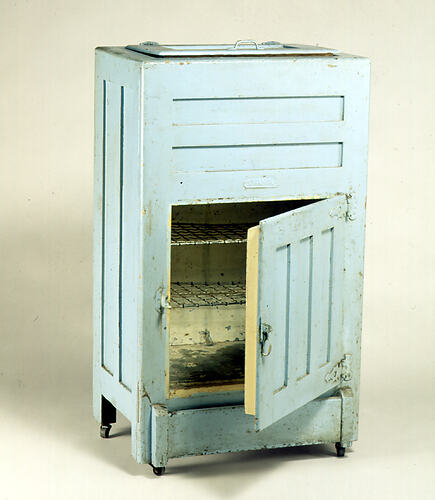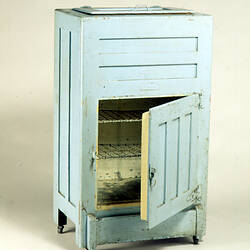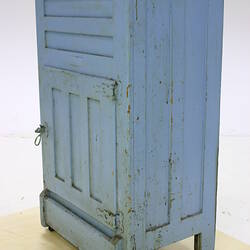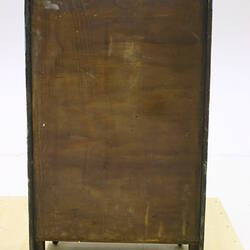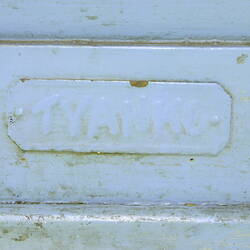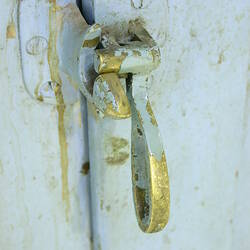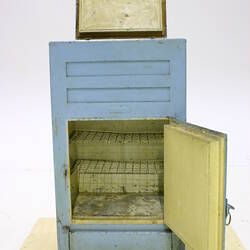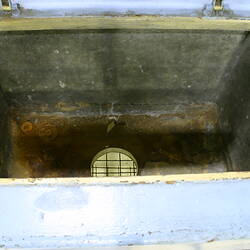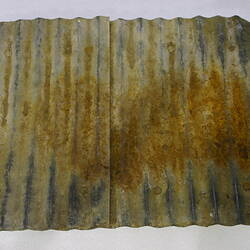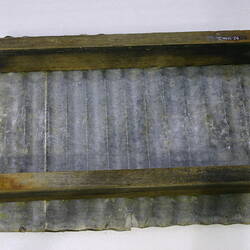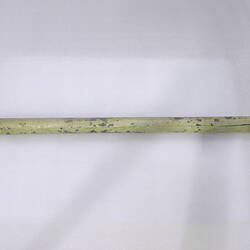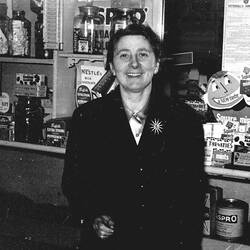Summary
Ice chest, made by Tyanko, circa 1939. Used at the Old Lolly Shop, Carlton North, from 1939.
The Old Lolly Shop was a milk bar opened and run by Elizabeth and Henry Cohen at 314 Rathdowne Street, Carlton North, from 1939 to 1975.
The ice chest is labelled 'TYANCO' - trading as Tye & Co, which had an office and factory in City Road, South Melbourne, from at least 1888. Tye & Co were advertising Tyanco ice chests from at least 1911, available for £2/12/6 upwards, as well as Tyanco sewing machines. The items were available from their premises at 100-108 Bourke Street, Melbourne. The company described itself as 'the money-saving house furnishers'. (Punch, 22/12/1911, p.42)
Physical Description
An upright rectangular shaped ice chest on four wheels, made of wood and metal, painted sky blue. FRONT: upper section, 2 indented horizontal panels of decoration, located middle centre a moulded product logo. A hinged wooden flap attached at the bottom of the chest. DOOR: 1/2 height. 3 indented, vertical panels of decoration. 2 ornate hinges on right. HANDLE - pull up lever handle/ latch, middle left. BACK: single panel of wood, unpainted. SIDES: 2 vertical rectangular panels. TOP: lid, 2 hinges at back. Central indented panel. HANDLE - D-shaped, centre of lid. INTERIOR: top compartment, reached via lid, unpainted tin. Small hole in rear for drainage and large hole centre bottom for cold air circulation. Ice tray 2 pieces of corrugated metal, overlapping, nailed to 2 parallel pieces of wood sits in centre. Metal pipe with hilt and traces of yellow paint. LID - metal lined, painted cream/ yellow. Bottom compartment painted cream/ yellow. 4 horizontal metal rods applied to sides, support 2 removable wire shelves.
Significance
Ice was the principle means of refrigeration until the late 19th century. In the United States and Australia non mechanised refrigerators, iceboxes, were used to keep perishable food fresh. Iceboxes continued to be used as the primary source of refrigeration for many families into the mid 20th century. Figures from the United States show that in 1923 iceboxes outsold mechanical refrigerators but that by 1944 refrigerators were outselling iceboxes by more than two to one. (Iereley 1999: 246) Figures for Australia are less comprehensive: a survey of appliance purchases in 1923 does not include refrigerators. By 1955, refrigerators are recorded: 77% of all homes in Brisbane, 83% in Sydney, and 67% in Melbourne. By 1964, it was estimated that 94% of all Australian households owned a refrigerator. (Dingle 1998: 124)These figures are supported by recorded oral histories, which demonstrate that in Australia many families were still using iceboxes in the late 1940s and 1950s. (Coleman; The-real-keneth-williams-story; Narrative 708)
An article in the New York Mirror from 1838 provides a clear definition of the standard icebox: it 'is a double box, the outside of mahogany or other wood, and the inside of sheet-zinc [or tin], the space between being three or four inches. By filling this space with finely powdered charcoal, well packed together, the box is rendered almost heat-proof, so that a lump of ice weighing five or six pounds may be kept twenty-four to thirty-six hours, even more, if the box is not opened too often, so as to admit the hot air from without. Of course while it is closed the air contained within it, being in contact with the ice, is reduced to nearly the same temperature; and meat is preserved perfectly sweet and good, the same as in winter. The interior of the refrigerator is provided with shelves for the reception of dishes, bottles, pitchers, etc.; and thus, by very simple contrivance, joints of meat are kept good for several days, wine is cooled, butter hardened, milk saved from "turning", and a supply of ice kept on hand for the more direct use of the table.' (Quote in Ierley 1999: 168)
The means of insulation described above was not standardised; fur pelt, hair, cork, wool, felt, ash and later asbestos were all used as insulating materials. The placement of the ice was also not standardised, though by the end of the nineteenth century it was generally placed in a tray at the top of the unit. A pipe for melted water ran from the ice tray to a drip tray underneath the icebox. This configuration allowed for air to circulate, enhancing the cooling effect - 'the denser cool air descending to the bottom and displacing the lighter warmer air, which rose to the top.' (Ierley 1999: 169)
References (deducted from statement above):
Merritt Ierley, 1999. Comforts of Home: The American House and the Evolution of Modern Convenience. New York : Three Rivers Press.
Dingle, Tony, 1998. Electrifying the kitchen in Interwar Victoria. Journal of Australian Studies. 22. 119-127. 10.1080/14443059809387386.
More Information
-
Collection Names
-
Collecting Areas
Migration & Cultural Diversity, Working Life & Trades, Home & Community
-
Acquisition Information
Donation from Mr Alan Cohen, 29 Apr 1992
-
Acknowledgement
Donated in memory of Elizabeth and Henry Cohen.
-
Manufacturer
-
User
The Old Lolly Shop, 314 Rathdowne Street, Carlton North, Greater Melbourne, Victoria, Australia, post 1939
-
Inscriptions
FRONT: logo "TYANKO".
-
Classification
-
Category
-
Discipline
-
Type of item
-
overall dimensions
42 cm (Length), 60.5 cm (Width), 104 cm (Height)
-
References
Merritt Ierley, 1999. Comforts of Home: The American House and the Evolution of Modern Convenience. New York : Three Rivers Press. Dingle, Tony, 1998. Electrifying the kitchen in Interwar Victoria. Journal of Australian Studies. 22. 119-127. 10.1080/14443059809387386. Advertising (1888, October 2). The Age (Melbourne, Vic. : 1854 - 1954), p. 4 (The Age Supplement Melbourne Centennial Exhibition). Retrieved August 2, 2019, from [Link 1] SILVERTOWN RUBBER CO. (1911, December 21). Punch (Melbourne, Vic. : 1900 - 1918; 1925), p. 42. Retrieved August 2, 2019, from [Link 2]
-
Keywords
Food Storage & Preservation, Refrigeration, Retailing, Shops, Working Life, Jewish Communities, Religions: Judaism
